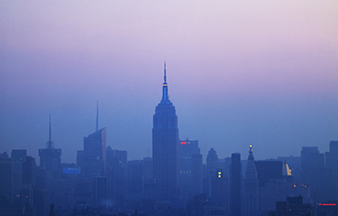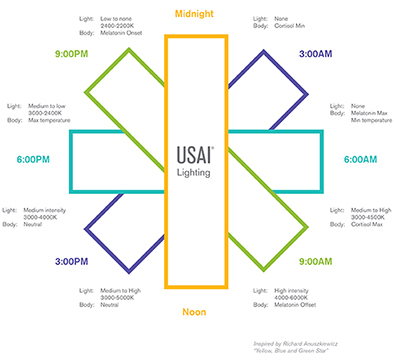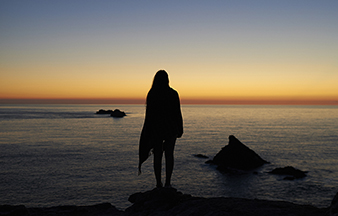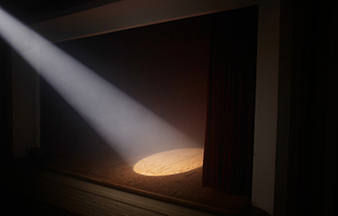Circadian Rhythm Lighting
 There is more to light than meets the eye — a lot more, in fact. While light enables us to see our world in vivid color and stunning detail, we have learned that light also regulates many biological responses in people which are not associated with our sense of sight, including an 'internal clock' in our bodies that makes us alert during the day and sleepy at night. The daily changes in our physical, mental and behavioral states that respond to a light-and-dark cycle is commonly known as our circadian rhythm. Just as a sunflower faces and tracks the sun to maximize the amount of sunshine it receives, historically people have always planned their lives around the availability of daylight. In the absence of man-made light sources, people rose with the dawn and went to sleep in the dark: when the sun went down and the campfire was reduced to ashes, the moon and stars provided our only light. Light around us signaled to our bodies when it was time to be active, and when it was time to rest. It was black and white. Light kept our daily lives in harmony with local time. This harmony is referred to as "entrainment": an entrained circadian system is aligned with the natural light/dark cycle of the solar day.
There is more to light than meets the eye — a lot more, in fact. While light enables us to see our world in vivid color and stunning detail, we have learned that light also regulates many biological responses in people which are not associated with our sense of sight, including an 'internal clock' in our bodies that makes us alert during the day and sleepy at night. The daily changes in our physical, mental and behavioral states that respond to a light-and-dark cycle is commonly known as our circadian rhythm. Just as a sunflower faces and tracks the sun to maximize the amount of sunshine it receives, historically people have always planned their lives around the availability of daylight. In the absence of man-made light sources, people rose with the dawn and went to sleep in the dark: when the sun went down and the campfire was reduced to ashes, the moon and stars provided our only light. Light around us signaled to our bodies when it was time to be active, and when it was time to rest. It was black and white. Light kept our daily lives in harmony with local time. This harmony is referred to as "entrainment": an entrained circadian system is aligned with the natural light/dark cycle of the solar day.
 When we review the anthropology of luminosity, we see that the invention of man-made lighting — from firelight and candlelight to the more advanced innovations of gaslight and, subsequently, electric lighting in the 19th century — changed all of that. Our activities are no longer limited by the setting of the sun: today we can arrive home in the dark, turn on the lights and tend to additional tasks, such as making dinner and enjoying hobbies. Man-made lighting boosted productivity by allowing us to continue to work late into the night, but simultaneously created a society that is no longer in sync with the local time. Think of the circadian system like a wind-up watch: it needs to be wound and set to the correct time every day, and if you do that it will continue ticking along like, well, like clockwork. Industrialized society spends most of its time indoors, within a built environment that can provide for our every need - but the electric lighting we are working and living under during the daytime does not match the dynamic quality and amount of light the sun can provide. Although the lights may be on indoors, we are in circadian darkness. Instead of the clear black and white signal our circadian systems used to receive, our internal clocks are operating in a world without contrast. Our days blur into nights. For most people living in modern society, we are forgetting to wind up the watch.
When we review the anthropology of luminosity, we see that the invention of man-made lighting — from firelight and candlelight to the more advanced innovations of gaslight and, subsequently, electric lighting in the 19th century — changed all of that. Our activities are no longer limited by the setting of the sun: today we can arrive home in the dark, turn on the lights and tend to additional tasks, such as making dinner and enjoying hobbies. Man-made lighting boosted productivity by allowing us to continue to work late into the night, but simultaneously created a society that is no longer in sync with the local time. Think of the circadian system like a wind-up watch: it needs to be wound and set to the correct time every day, and if you do that it will continue ticking along like, well, like clockwork. Industrialized society spends most of its time indoors, within a built environment that can provide for our every need - but the electric lighting we are working and living under during the daytime does not match the dynamic quality and amount of light the sun can provide. Although the lights may be on indoors, we are in circadian darkness. Instead of the clear black and white signal our circadian systems used to receive, our internal clocks are operating in a world without contrast. Our days blur into nights. For most people living in modern society, we are forgetting to wind up the watch.
 This mismatch or lack of entrainment, between our internal clock and the local time disrupts our circadian system. Limitations in early lighting technologies and our understanding of lighting and its impact on health have inadvertently contributed to this. Nighttime use of electric lighting and electronic devices with bright screens — from smart phones to tablets, laptops to big-screen TVs — expose us to blue light at the wrong times, which contributes to and exacerbates circadian disruption. Research now tells us that a disrupted circadian system is connected to a whole host of long-term health and behavioral problems: fatigue, cancer, obesity, diabetes, depression, mood and sleep disorders, reduced physical and mental performance, reduced productivity and irritability are all related in some shape or form to a circadian system that isn't functioning the way it's supposed to. In fact, exposure to blue-rich light at night has been shown as the worst offender when it comes to disrupting our sleep/wake cycle. This all sounds pretty grim, until you consider the good news: the advent of light emitting diodes (LEDs) and our new knowledge of lighting's role for circadian health can help put us back on track, or at least closer to it, for improved health and well being.
This mismatch or lack of entrainment, between our internal clock and the local time disrupts our circadian system. Limitations in early lighting technologies and our understanding of lighting and its impact on health have inadvertently contributed to this. Nighttime use of electric lighting and electronic devices with bright screens — from smart phones to tablets, laptops to big-screen TVs — expose us to blue light at the wrong times, which contributes to and exacerbates circadian disruption. Research now tells us that a disrupted circadian system is connected to a whole host of long-term health and behavioral problems: fatigue, cancer, obesity, diabetes, depression, mood and sleep disorders, reduced physical and mental performance, reduced productivity and irritability are all related in some shape or form to a circadian system that isn't functioning the way it's supposed to. In fact, exposure to blue-rich light at night has been shown as the worst offender when it comes to disrupting our sleep/wake cycle. This all sounds pretty grim, until you consider the good news: the advent of light emitting diodes (LEDs) and our new knowledge of lighting's role for circadian health can help put us back on track, or at least closer to it, for improved health and well being.
 Today, we know that the color and the amount of light we use, the length and time of day we are exposed to it, and even the direction within the field of view that light enters our eyes are important considerations. It is widely accepted that daylight, as the first and most natural light source, serves as the benchmark that electric lighting needs to mimic in order to optimize circadian health and wellbeing. What does daylight have that most forms of electric lighting do not? It's dynamic - ranging from really, really bright, to complete darkness. It's variable - from incredibly clear blue skies to lovely fuchsia sunsets. And timing is everything. Daylight provides bright, blue-rich light in the early morning to deliver an alerting signal as we wake up - but exposure to that same light at night can keep you up at night, and throw off your game the next day. In the early evening, daylight provides a warm, low-level light to cue our bodies for a period of rest. Why wouldn't we want to replicate this natural light cycle with our interior lighting, to give ourselves the best chance of feeling good from day to day? This is where our new knowledge, coupled with the dynamic features and potential that LED lighting technology gives us today, puts us in a position where we can now create personalized lighting to mitigate circadian disruption, optimize mood and visual experience, and improve our sense of wellbeing, in better ways than ever before.
Today, we know that the color and the amount of light we use, the length and time of day we are exposed to it, and even the direction within the field of view that light enters our eyes are important considerations. It is widely accepted that daylight, as the first and most natural light source, serves as the benchmark that electric lighting needs to mimic in order to optimize circadian health and wellbeing. What does daylight have that most forms of electric lighting do not? It's dynamic - ranging from really, really bright, to complete darkness. It's variable - from incredibly clear blue skies to lovely fuchsia sunsets. And timing is everything. Daylight provides bright, blue-rich light in the early morning to deliver an alerting signal as we wake up - but exposure to that same light at night can keep you up at night, and throw off your game the next day. In the early evening, daylight provides a warm, low-level light to cue our bodies for a period of rest. Why wouldn't we want to replicate this natural light cycle with our interior lighting, to give ourselves the best chance of feeling good from day to day? This is where our new knowledge, coupled with the dynamic features and potential that LED lighting technology gives us today, puts us in a position where we can now create personalized lighting to mitigate circadian disruption, optimize mood and visual experience, and improve our sense of wellbeing, in better ways than ever before.
 Although light and health discoveries are in their infancy, with so many more exciting new discoveries to come, we believe that the potential benefits of using this new knowledge are vast. Today, we know how to create lighting prescriptions to eliminate jet lag, improve sleep quality, alleviate symptoms of Alzheimer's disease, ease depression, improve worker satisfaction, and be happier people overall. Many of these ailments have no cure today, but we can provide relief through lighting! Today's advancements in LED lighting technology are leading the way for design by providing lighting professionals with the tools they need to improve our quality of life.
Although light and health discoveries are in their infancy, with so many more exciting new discoveries to come, we believe that the potential benefits of using this new knowledge are vast. Today, we know how to create lighting prescriptions to eliminate jet lag, improve sleep quality, alleviate symptoms of Alzheimer's disease, ease depression, improve worker satisfaction, and be happier people overall. Many of these ailments have no cure today, but we can provide relief through lighting! Today's advancements in LED lighting technology are leading the way for design by providing lighting professionals with the tools they need to improve our quality of life.
This is an exciting time for the lighting industry. There are many promising LED products on the market now to support circadian health, including USAI Lightings's tunable white light technology, Color Select. Color Select is noteworthy, because it currently has the widest range of tunable white light color temperatures available, from a candlelight-like 2200K to a 6000K you would only see in bright daylight. By independently adjusting light levels and color temperatures, the full dynamic range of natural daylight can be recreated in an interior space. The entire product line has been designed to be compatible with all industry-standard architectural lighting controls, which means that the end user can take advantage of Color Select's functionality, regardless of the controls chosen. And, if the building control system uses an astronomical time clock, Color Select can be commissioned to change color temperature and light level automatically, allowing for the reproduction of outdoor lighting conditions in a windowless office, or bring the calm of a sunny day to a board meeting. Perhaps most importantly, the lighting can be preprogrammed to provide a daily dose of high energy white light in the morning to start the day as daylight would, and dynamically shift to settings more amenable to teamwork and collaboration at the times you choose. Nonvisual effects are what we want and need from our lighting today, and this can be done easily and simply with Color Select.
 If we are going to implement prescription lighting solutions, and recreate natural daylight with electric lighting, additional tools will be used to guide us. There are new lighting metrics, such as circadian light (CLA), circadian stimulus (CS), melanopic lux and others that are emerging to guide lighting product development and lighting design practice. Although perhaps not well understood by many, several forward-thinking companies are already taking the initiative to ask for products that can meet new "well" standards based on the metrics and research we have today. These standards call for the utilization of advanced lighting products that can address the modern need for circadian entrainment. Going forward, we will implement architectural lighting technologies and solutions that will make the best use of current findings in medical science and human factors research, while also advancing the state of the art in lighting. Innovations in LED lighting and controls continue to elevate the human experience each day. We will delve deeper into these developments and topics in future articles, so please stay tuned!
If we are going to implement prescription lighting solutions, and recreate natural daylight with electric lighting, additional tools will be used to guide us. There are new lighting metrics, such as circadian light (CLA), circadian stimulus (CS), melanopic lux and others that are emerging to guide lighting product development and lighting design practice. Although perhaps not well understood by many, several forward-thinking companies are already taking the initiative to ask for products that can meet new "well" standards based on the metrics and research we have today. These standards call for the utilization of advanced lighting products that can address the modern need for circadian entrainment. Going forward, we will implement architectural lighting technologies and solutions that will make the best use of current findings in medical science and human factors research, while also advancing the state of the art in lighting. Innovations in LED lighting and controls continue to elevate the human experience each day. We will delve deeper into these developments and topics in future articles, so please stay tuned!

|

|
Tweet |



